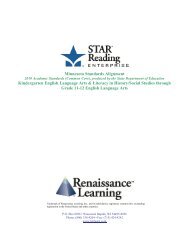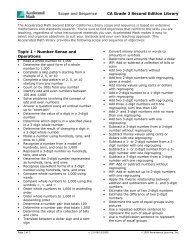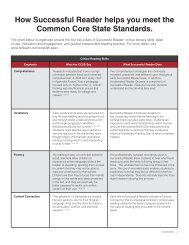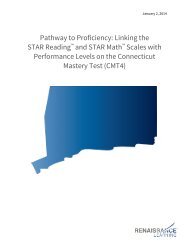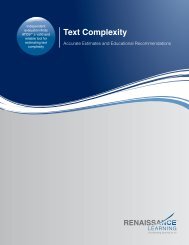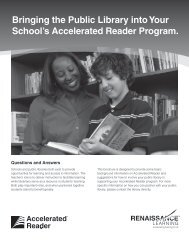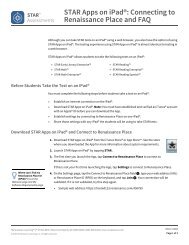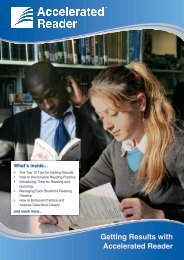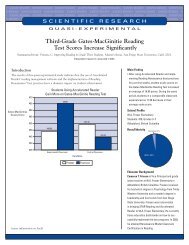Technical Manual - Renaissance Learning
Technical Manual - Renaissance Learning
Technical Manual - Renaissance Learning
Create successful ePaper yourself
Turn your PDF publications into a flip-book with our unique Google optimized e-Paper software.
STAR Early Literacy Enterprise in the ClassroomApproaches and Rationales for Recommended UsesDiagnostic AssessmentOne of the most powerful features of STAR Early Literacy Enterprise is its ability tofunction as a diagnostic assessment as described in No Child Left Behind. Theprogram canidentify a student’s specific areas of strength and weaknessdetermine any difficulties that a student may have in learning to readidentify the potential cause of the difficultieshelp teachers determine appropriate reading intervention strategiesThe Diagnostic–Student Report (also called the Student Diagnostic Report SkillSet Scores) is the ideal way to identify students’ strengths and weaknesses. Itdisplays Scaled Scores and reading development stage classifications forindividual students and categorizes all Skill Set Scores into a table of strengthsand weaknesses in each of the ten literacy sub-domains. By referring to this report,teachers can develop instructional strategies that capitalize on students’strengths and help students overcome their weaknesses.A related report, the Score Distribution Report, is a classroom-level summary ofstudents’ skills. It shows the number of students in each of four score categoriesfor the 41 Skill Set Scores provided by STAR Early Literacy Enterprise. The ScoreDistribution Report allows teachers to group students for instruction by the skillsthat need improvement so that instruction can be both efficient and effective.Progress MonitoringResearch has shown that students whose progress is monitored regularly makegreater gains than other students. Progress monitoring, sometimes calledcurriculum based assessment or curriculum based measurement, is anassessment conducted on a routine basis, weekly or monthly, that shows how wellstudents are moving toward goals that have been established for them.Information gathered from progress monitoring is used to compare expected andactual rates of learning and to modify instruction as needed.Beyond improving instruction, progress monitoring is an appropriate way to meetthe adequate yearly progress (AYP) requirement of No Child Left Behind. Bymonitoring students’ progress on a regular basis, teachers will be able to identifythose who are on track to meet yearly goals and those who will require additionallearning opportunities.STAR Early Literacy Enterprise is an ideal way to conduct progress monitoringassessment. It reports student level information at the skill, sub-domain, or scaledscore level and can be used on a weekly basis. The item pool is large enough tosupport frequent assessment using alternate forms that reflect the current level ofSTAR Early Literacy<strong>Technical</strong> <strong>Manual</strong>125





